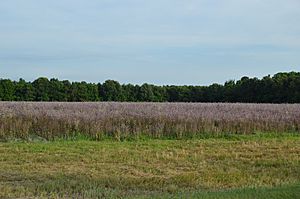Clary facts for kids
Quick facts for kids Clary |
|
|---|---|
 |
|
| Scientific classification | |
| Genus: |
Salvia
|
| Species: |
sclarea
|
Salvia sclarea, often called clary or clary sage, is a special plant. It can live for two years (biennial) or for a few years (short-lived perennial). It belongs to the Salvia family, which includes many types of sage.
This plant originally comes from the northern Mediterranean region. You can also find it in parts of North Africa and Central Asia. People have used Clary Sage for a very long time as an herb. Today, it's often grown to make a special liquid called essential oil.
Contents
What Does Clary Sage Look Like?
Clary Sage plants can grow quite tall, reaching about 3 to 4 feet (1 to 1.2 meters) high. They have thick, square stems that are covered in soft hairs.
The leaves are large, especially at the bottom of the plant, where they can be about 1 foot (30 cm) long. Higher up, the leaves are smaller, around 0.5 feet (15 cm) long. The top surface of the leaves feels rough and has tiny, sticky hairs.
The flowers grow in groups called verticils, with 2 to 6 flowers in each group. These flowers are surrounded by large, colorful leaves called bracts. These bracts can be pale purple, lilac, white, or pink, often with a pink mark on the edge. The actual flower, called the corolla, is usually lilac or pale blue and about 1 inch (2.5 cm) long. Its "lips" are held wide open.
There's a special type of Clary Sage called 'Turkestanica'. This one has pink stems, leaves with stalks, and white flowers with pink spots. These flowers grow on tall spikes up to 30 inches (76 cm) high.
Clary Sage Through History
People have written about using Clary Sage for medicine for a very long time. Ancient writers like Theophrastus (who lived in the 4th century BCE), Dioscorides (1st century CE), and Pliny the Elder (1st century CE) all mentioned it.
Clary seeds have a sticky coating. Because of this, some old herb books suggested putting a seed into someone's eye if they had something stuck in it. The idea was that the sticky seed would attach to the object, making it easier to remove. A writer named Nicholas Culpeper wrote about this practice in his book Complete Herbal in 1653. He even called the plant "clear-eye" because of this use.
Clary Sage was also used in making drinks like wine and beer. In Germany during the 1500s, people would add Clary Sage infused with elderflower to Rhine wines. This made a stronger type of wine known as Muscatel.
How Clary Sage Is Used Today
Today, the essential oil made from Clary Sage is very popular. It's used a lot in perfumes because of its unique scent. It also gives a muscatel (grape-like) flavor to drinks like vermouths, wines, and liqueurs.
Clary Sage essential oil is also used in aromatherapy. This is a practice where essential oils are used to help people relax or feel better.
In the United States, a lot of Clary Sage is grown in large fields. Most of this farming happens in northeastern North Carolina, especially in the areas around Bertie County.
Gallery
See also
 In Spanish: Salvia sclarea para niños
In Spanish: Salvia sclarea para niños










